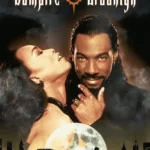 Wes Craven’s 1995 film Vampire in Brooklyn is one of those movies that exists in a strange, mesmerizing limbo—simultaneously ambitious, hilarious, and bafflingly uneven. It’s a horror-comedy that aspires to blend urban vampire mythology, supernatural thrills, and Eddie Murphy’s signature humor, and in doing so, manages to be both wildly entertaining and infuriatingly flawed. “Awesome terrible” is the perfect descriptor: the film is stylish, audacious, and occasionally brilliant, yet narratively inconsistent, tonally erratic, and sometimes head-scratchingly absurd. Watching it is a curious experience, where you can marvel at its creativity while groaning at its execution.
Wes Craven’s 1995 film Vampire in Brooklyn is one of those movies that exists in a strange, mesmerizing limbo—simultaneously ambitious, hilarious, and bafflingly uneven. It’s a horror-comedy that aspires to blend urban vampire mythology, supernatural thrills, and Eddie Murphy’s signature humor, and in doing so, manages to be both wildly entertaining and infuriatingly flawed. “Awesome terrible” is the perfect descriptor: the film is stylish, audacious, and occasionally brilliant, yet narratively inconsistent, tonally erratic, and sometimes head-scratchingly absurd. Watching it is a curious experience, where you can marvel at its creativity while groaning at its execution.
The story begins with Detective Rita Veder (Angela Bassett), a strong, intelligent, and no-nonsense cop, investigating a series of mysterious deaths in Brooklyn. These murders are linked to a charismatic and enigmatic vampire named Maximillian (Eddie Murphy), who has returned to his birthplace with an agenda that blends seduction, power, and supernatural menace. Maximillian’s plan revolves around choosing a female descendant to continue his bloodline, and Rita soon finds herself embroiled in this dark, seductive world. The narrative mixes procedural investigation, horror tropes, and comedic beats, all while attempting to create a unique urban vampire mythology.
One of the most striking elements of Vampire in Brooklyn is its visual style. Craven, a master of horror in films such as A Nightmare on Elm Street and Scream, brings a polished, gothic flair to the Brooklyn setting. Cinematographer Mark Irwin crafts a moody, atmospheric world where night streets, shadowy apartments, and opulent interiors collide with the mundane urban landscape. The film embraces a heightened reality, with fog, dramatic lighting, and stylized camera angles enhancing both suspense and supernatural spectacle. At times, these visual choices are mesmerizing, giving the film a darkly romantic, almost comic-book quality.
Eddie Murphy’s performance is central to the “awesome” side of the movie. Known primarily for his comedic prowess, Murphy fully commits to the role of Maximillian, blending charm, menace, and occasional camp. He is magnetic on screen, with a presence that is both seductive and terrifying. His comedic timing is employed in moderation, which allows the character to retain a sense of menace while still delivering the occasional sly, humorous line. Murphy’s performance is both entertaining and ambitious, demonstrating his willingness to step outside his usual comedic comfort zone.
Angela Bassett’s Detective Rita Veder provides a much-needed counterbalance. Bassett exudes authority, intelligence, and strength, anchoring the film emotionally and narratively. Rita’s character is a refreshing departure from the typical horror heroine; she is competent, assertive, and unflinching in the face of supernatural threats. The dynamic between Rita and Maximillian forms the emotional core of the film, blending tension, attraction, and moral conflict in a way that keeps the audience invested. Bassett’s performance is one of the film’s most consistently strong elements, elevating scenes that might otherwise be lost in the film’s tonal inconsistencies.
Where Vampire in Brooklyn truly shines is in its ambition. Craven attempts to blend horror, comedy, and social commentary, creating a film that is as much about atmosphere and character as it is about scares. The movie explores themes of power, desire, and identity, using the vampire mythos as a lens to examine human ambition, seduction, and the predatory nature of some relationships. This thematic ambition sets it apart from more straightforward horror-comedies, giving it depth that is often surprising amidst the blood, fangs, and occasional absurdity.
Yet the film is undeniably “terrible” in many respects. The tonal balance is precarious at best. Craven struggles to juggle horror, comedy, and urban drama, resulting in abrupt shifts that can feel jarring. A scene that starts as genuinely suspenseful can quickly dissolve into slapstick humor or over-the-top theatrics, leaving viewers unsure of how to react. Some sequences, particularly those involving secondary characters or subplots, feel underdeveloped or extraneous, further highlighting narrative inconsistencies. These issues contribute to the film’s enduring charm as an “awesome terrible” experience: it is as fun as it is flawed, unpredictable as it is uneven.
Supporting performances are a mixed bag. Allen Payne, who plays Detective Justice, and other secondary cast members provide occasional comedic relief and narrative support, but many of these characters are thinly sketched. They exist primarily to advance the plot, deliver exposition, or serve as victims of Maximillian’s predation. This uneven character development occasionally hampers the film’s storytelling, making certain plot points feel rushed or unearned. Yet these imperfections also contribute to the film’s unique flavor, creating a world that is simultaneously immersive and slightly chaotic.
The horror elements are similarly uneven. Some sequences, like Maximillian’s first dramatic display of vampire power or the climactic confrontation, are genuinely tense and visually impressive. Craven employs shadow, sound design, and practical effects to create suspense and gore, giving the film its most traditional horror thrills. Other moments, however, rely heavily on Murphy’s charm or comedic antics, which undercut the tension. This oscillation between horror and comedy is a defining characteristic of the movie, making it thrilling, unpredictable, and occasionally frustrating.
The film’s humor is another divisive element. Murphy’s wit and charisma shine in several scenes, particularly when his character interacts with unsuspecting humans or delivers sly, sardonic commentary. However, the comedic beats are sometimes unevenly placed, clashing with moments of genuine suspense or emotional intensity. This results in a film that can feel tonally confused—one moment tense and frightening, the next absurdly humorous. Yet it is precisely this tonal audacity that makes Vampire in Brooklyn memorable and entertaining. It is a movie that dares to take risks, even when those risks don’t always pay off.
The urban setting adds a layer of authenticity and style to the film. Unlike traditional Gothic vampire tales set in European castles or remote landscapes, Vampire in Brooklyn grounds the story in a contemporary, recognizable environment. This urban backdrop allows the film to explore issues of community, identity, and social dynamics while still delivering supernatural thrills. Craven uses Brooklyn as more than a backdrop; it becomes a character in itself, shaping the story’s mood and providing context for the unfolding drama. The contrast between familiar city life and supernatural horror heightens both tension and absurdity.
Despite its flaws, the film has moments of genuine creativity and spectacle. The visual effects, particularly in scenes depicting vampire transformation and supernatural feats, are imaginative and occasionally stunning. The makeup and costume design, particularly for Maximillian, reinforce the character’s charisma and menace. Craven’s direction embraces theatricality, allowing scenes to feel larger-than-life while still maintaining a sense of narrative cohesion in the best moments. These sequences exemplify the “awesome” side of the film: visually engaging, thematically ambitious, and frequently entertaining.
The film’s pacing is uneven but occasionally deliberate in a way that enhances suspense. Scenes that linger on character interactions or atmospheric details contribute to mood and world-building, though at times they feel indulgent or slow the narrative momentum. Conversely, some plot developments occur abruptly, leaving viewers scrambling to keep up. This uneven rhythm is a hallmark of “awesome terrible” cinema: the film keeps you engaged, intrigued, and occasionally exasperated, creating a viewing experience that is as unpredictable as it is entertaining.
The music and soundtrack add another layer to the film’s unique style. The score complements the urban setting and supernatural elements, blending tension, humor, and mood effectively. While not particularly iconic, it supports the narrative and enhances key sequences, particularly those involving suspense or transformation. Combined with Craven’s visual flair, the music helps create a cohesive aesthetic that is both entertaining and immersive.
Ultimately, Vampire in Brooklyn is a film of contradictions. It is stylish yet uneven, ambitious yet flawed, humorous yet terrifying. Its charm lies in its audacity—Craven takes risks, blending genres, tones, and performances in ways few directors attempt. The result is a movie that captivates, frustrates, and entertains in equal measure. It is an experience defined by extremes: moments of brilliance punctuated by absurdity, tension offset by comedy, and horror interwoven with charisma and charm.
Thematically, the film remains surprisingly thoughtful for a horror-comedy. At its core, it is a story about desire, power, identity, and moral choice. Maximillian’s vampirism serves as a metaphor for predatory behavior, charisma, and unchecked ambition, while Rita’s determination and moral clarity provide a counterpoint that anchors the story. This thematic depth elevates the film beyond mere supernatural spectacle, giving audiences something to think about even amid the blood, fangs, and occasional absurdity.
In the end, Vampire in Brooklyn is a quintessential “awesome terrible” movie. It is audacious, unpredictable, and visually engaging, yet narratively uneven, tonally inconsistent, and occasionally absurd. Eddie Murphy’s magnetic performance, Angela Bassett’s commanding presence, and Craven’s stylistic flair create a film that is entertaining, memorable, and endlessly discussable. Its flaws are part of its charm, contributing to a cinematic experience that is equal parts thrilling, amusing, and bewildering.
For those willing to embrace its contradictions and absurdities, Vampire in Brooklyn offers a wild ride through horror, comedy, and urban supernatural intrigue. It is a film that can entertain, frustrate, and delight in the same scene—a rare feat that earns it its “awesome terrible” reputation. It is not perfect, but it is unforgettable, a film that remains a cult favorite for its boldness, ambition, and sheer audacity.
This post has already been read 21 times!




